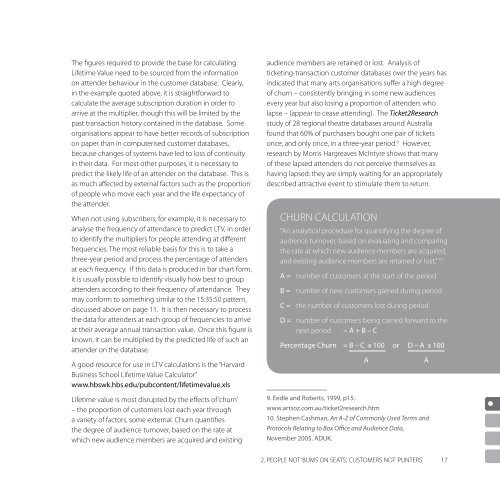FULL HOUSE Turning Data into Audiences - ARTS Australia
FULL HOUSE Turning Data into Audiences - ARTS Australia
FULL HOUSE Turning Data into Audiences - ARTS Australia
Create successful ePaper yourself
Turn your PDF publications into a flip-book with our unique Google optimized e-Paper software.
The figures required to provide the base for calculatingLifetime Value need to be sourced from the informationon attender behaviour in the customer database. Clearly,in the example quoted above, it is straightforward tocalculate the average subscription duration in order toarrive at the multiplier, though this will be limited by thepast transaction history contained in the database. Someorganisations appear to have better records of subscriptionon paper than in computerised customer databases,because changes of systems have led to loss of continuityin their data. For most other purposes, it is necessary topredict the likely life of an attender on the database. This isas much affected by external factors such as the proportionof people who move each year and the life expectancy ofthe attender.When not using subscribers, for example, it is necessary toanalyse the frequency of attendance to predict LTV, in orderto identify the multipliers for people attending at differentfrequencies. The most reliable basis for this is to take athree-year period and process the percentage of attendersat each frequency. If this data is produced in bar chart form,it is usually possible to identify visually how best to groupattenders according to their frequency of attendance. Theymay conform to something similar to the 15:35:50 pattern,discussed above on page 11. It is then necessary to processthe data for attenders at each group of frequencies to arriveat their average annual transaction value. Once this figure isknown, it can be multiplied by the predicted life of such anattender on the database.A good resource for use in LTV calculations is the “HarvardBusiness School Lifetime Value Calculator”www.hbswk.hbs.edu/pubcontent/lifetimevalue.xlsLifetime value is most disrupted by the effects of ‘churn’– the proportion of customers lost each year througha variety of factors, some external. Churn quantifiesthe degree of audience turnover, based on the rate atwhich new audience members are acquired and existingaudience members are retained or lost. Analysis ofticketing-transaction customer databases over the years hasindicated that many arts organisations suffer a high degreeof churn – consistently bringing in some new audiencesevery year but also losing a proportion of attenders wholapse – (appear to cease attending). The Ticket2Researchstudy of 28 regional theatre databases around <strong>Australia</strong>found that 60% of purchasers bought one pair of ticketsonce, and only once, in a three-year period. 9 However,research by Morris Hargreaves McIntyre shows that manyof these lapsed attenders do not perceive themselves ashaving lapsed: they are simply waiting for an appropriatelydescribed attractive event to stimulate them to return.CHURN CALCULATION“An analytical procedure for quantifying the degree ofaudience turnover, based on evaluating and comparingthe rate at which new audience members are acquired,and existing audience members are retained or lost.” 10A = number of customers at the start of the periodB = number of new customers gained during periodC = the number of customers lost during periodD = number of customers being carried forward to thenext period = A + B – CPercentage Churn = B – C x 100 or D – A x 1009. Eedle and Roberts, 1999, p15.www.artsoz.com.au/ticket2research.htm10. Stephen Cashman, An A-Z of Commonly Used Terms andProtocols Relating to Box Office and Audience <strong>Data</strong>,November 2005, ADUK.aA2. PEOPLE NOT ‘BUMS ON SEATS’, CUSTOMERS NOT ‘PUNTERS’17


